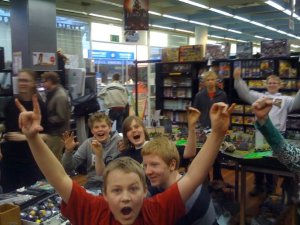I recently started (and ended) a very short-lived RPG campaign with the stated goal of using Paizo’s Pathfinder RPG rules set, and Paizo’s Serpent’s Skull Adventure Path, but with the rules mechanics pared down to resemble earlier versions of D&D, and with the Old School no-nonsense sensibilities of gaming style, e.g. lethality, rulings not rules, no battle mat, rolled attributes straight down the line, only four character classes and three races, considerably less skill points, slower feat progression, no easy access to healing magic, and no resurrection of any kind. An ambitious rules hack to be sure, and an interesting experiment on the compatibility of, in my opinion, two very different rules sets and the gaming styles derived thereof.
To start of, let me state that I’m strongly of the opinion, that rules sets are never just “the rules” and thus separate from the game world and what the actual game is like, but always strongly connected, e.g. the rules describe the metaphysics of the game world, and thus form the meta-culture of the way the game is played as a whole. You cannot separate the two more than you could use a spoon to extract oxygen from water.
The gaming group I had consisted of two players with a wide range of experience with different editions of D&D, including Mentzer D&D, AD&D, Pathfinder, and Lamentations of the Flame Princess; a player who had only played LotFP before this; and two players who had only played WotC 3.5./Pathfinder. The characters were created at the start of the first game session. We ended up with a fighter, two clerics, a rogue and a wizard, e.g. all four available classes represented.
Right off the bat we ran into some group dynamic problems, when one of the PF-players concocted an rather convoluted character backstory, which was soon revealed to the other players, but not the other characters. This is for for the most part fine when playing some more modern RPG’s, but for an old school style game, it just doesn’t work, as the intent is that first level characters aren’t supposed to really have complex backstories (“Character background is what happens during levels 1-4” -G.Gygax), and also, in old school play, the line between player and character knowledge is so blurred it might as well be non-existent. The backstory had other problems as well (for one, the character was the cleric of an evil deity), but these problems have little to do with the topic of this post.
It soon became apparent, that there would be problems in more than one area. For one, the players who were only familiar with Type III were in no way prepared for how lethal combat becomes, when the characters aren’t superheroes anymore. Instead (as typical of Type III play), then met dangers head on with the expectation, that of course the challenge would be level-appropriate, thus providing a safe and sanitized moment of heroics, that would at most drain some consumable resources. Not so in old school, though. A few character deaths later, and they were starting to pay more attention to the fact, that the best way to survive is to avoid fighting, and if things start to look grim, its time to run. One also needs to realize, that sometimes not even the best preparations in the world will save characters from totally random death by trap or poison. This is also a feature (not a bug, mind you) not really present in Type III, but there in abundance in old school play.
An unexpected development from the rules changes was this: Since a lot of the combat rules and of course the battle mat of Type III wasn’t used, a lot more of what was actually happening in the game rested on so-called GM fiat. The actions of players had become decidedly less important than the description provided by the GM. This is something I’ve become very familiar with when running White Wolf games, where the system itself doesn’t tell you much of what’s happening. For White Wolf games, however, that’s perfectly OK, since the emphasis is supposed to be storytelling, not conflict resolution. In old school games, however, it most definitely isn’t OK, since the GM is supposed to be an impartial referee who just sets the challenges, rolls the dice, and lets them fall where they may. In fact, that particular trait of storytelling games is one of the main reasons why I started to gravitate away from them towards the OSR some years ago. Why was this happening, though?
I came to this conclusion: Since a pared down, or “vague” rules-system (such as Storyteller and my chopped up Pathfinder) sets a framework that tells you what the rules are like, without providing the actual nitty-gritty on how it actually works, the blanks (e.g. setting appropriate challenges and moderating troublespots) are left for the GM to fill. In my experience, this doesn’t really happen with either Pathfinder proper or with old school games. I think I need to ponder on this some more, though.
In conclusion, the experiment was successful in proving that a proper merger of two game systems so dissimilar is impossible without sacrificing some of the traits that are essential to actually making said game systems what they are. Pathfinder is fine if you want to run a system-heavy heroic game, with an incredibly detailed combat system, and old school style games work the best when using an old school style rules system. Oh, and of course Storyteller (briefly mentioned) is just fine if you don’t care about system at all, and would rather concentrate on co-operative storytelling.
Did I learn anything? Maybe. Next up, something completely different.









